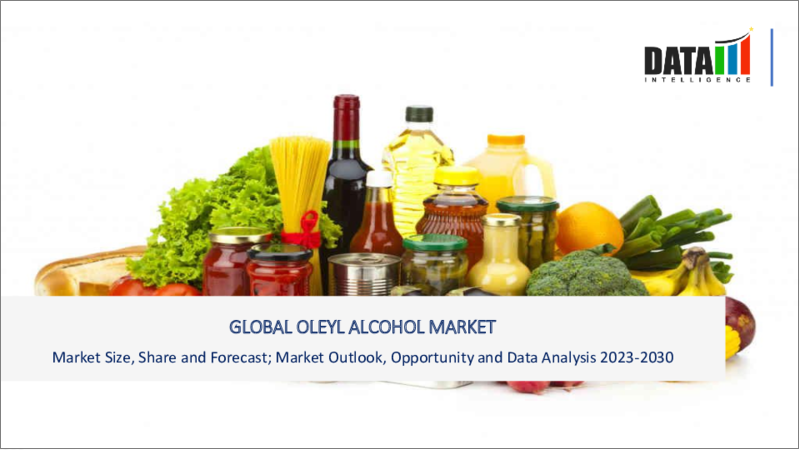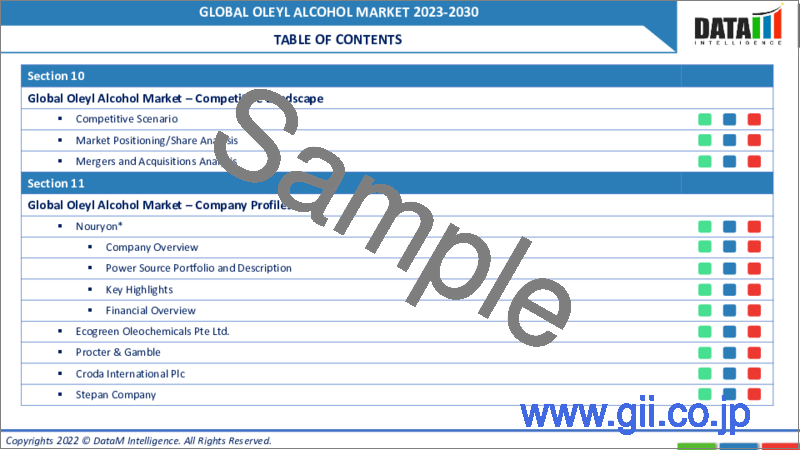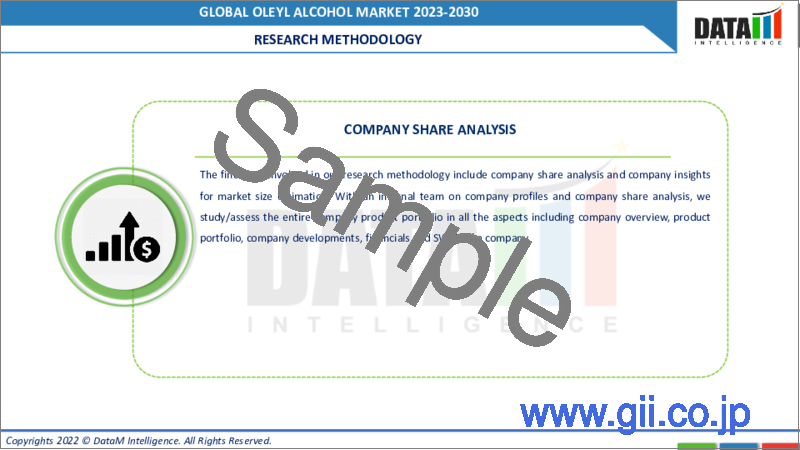|
|
市場調査レポート
商品コード
1179931
オレイルアルコールの世界市場-2022-2029Global Oleyl Alcohol Market - 2022-2029 |
||||||
|
● お客様のご希望に応じて、既存データの加工や未掲載情報(例:国別セグメント)の追加などの対応が可能です。 詳細はお問い合わせください。 |
|||||||
| オレイルアルコールの世界市場-2022-2029 |
|
出版日: 2023年01月05日
発行: DataM Intelligence
ページ情報: 英文 170 Pages
納期: 約2営業日
|
- 全表示
- 概要
- 目次
市場力学
環境に優しい界面活性剤に対する消費者の意識が高まり、オレイルアルコール市場が成長
界面活性剤市場における最大のビジネスチャンスの1つは、バイオベースの界面活性剤であり、環境に優しい製品に対する消費者の意識の高まりが、オレイルアルコールの界面活性剤需要を大きく後押ししています。界面活性剤は、発泡剤、乳化剤、洗浄剤、湿潤剤として、幅広い用途に使用されています。界面活性剤の特徴として、コンディショニング性、洗浄性などが挙げられ、幅広い用途に使用されています。オレイルアルコール系界面活性剤は、パーソナルケア、繊維、医薬品、石鹸、洗剤などの産業で幅広く使用されています。
また、オレイルアルコールは、繊維の可塑剤などにも使用されています。ライフスタイルの変化やアジア太平洋およびラテンアメリカの経済諸国の開拓により、可塑剤に含まれるオレイルアルコールの市場は顕著な成長を遂げています。さらに、ブラジル、ロシア、中国、インドなどの新興経済諸国における市場開拓や、環境意識の高まり、法的要求事項によって、オレイルアルコール市場は後押しされています。主要メーカーは、新製品を販売し、市場シェアを拡大するために、他の企業と協力し、いくつかの契約を締結しています。例えば、2021年5月7日、PT.Ecogreen Oleochemicalsは、飽和脂肪アルコールのブレンドであるECOROL(R)を発売しました。脂肪アルコールは、脂肪アルコールエトキシレート、脂肪アルコールサルフェート、脂肪アルコールエトキシサルフェートの形で界面活性剤に広く使用されています。これらは、パーソナルケア、オーラルケア、洗濯用洗剤、食器用洗剤、表面洗浄剤、化粧品のクリームやローションによく含まれています。その他の工業用途としては、酸化防止剤、香料、繊維柔軟剤、可塑剤、金属加工、農薬中間体などがあります。その飽和脂肪アルコールは、PT Ecogreen Oleochemicals Batamで入手可能です。
目次
第1章 調査手法と範囲
- 調査手法
- 市場の範囲
第2章 主な動向と発展
第3章 エグゼクティブサマリー
- ソース別市場内訳
- アプリケーション別市場内訳
- 地域別市場内訳
第4章 市場力学
- 市場影響要因
- 促進要因
- 抑制要因
- ビジネスチャンス
- 影響分析
第5章 産業分析
- ポーターのファイブフォース分析
- サプライチェーン分析
- 特許分析
- 規制分析
第6章 COVID-19の分析
- COVID-19の市場に関する分析
- COVID-19以前の市場シナリオ
- COVID-19の現在の市場シナリオ
- COVID-19の後、または将来のシナリオ
- COVID-19の中での価格ダイナミクス
- 需要-供給スペクトラム
- パンデミック時の市場に関連する政府の取り組み
- メーカーの戦略的取り組み
第7章 供給元別
- ビードオイル
- フィッシュオイル
- オリーブオイル
- その他
第8章 用途別
- 化粧品・パーソナルケア
- 飲食品
- 医薬品
- 界面活性剤
- 繊維
- その他
第9章 地域別
- 北米
- 米国
- カナダ
- メキシコ
- 南米
- ブラジル
- アルゼンチン
- その他の南米地域
- 欧州
- ドイツ
- 英国
- フランス
- スペイン
- イタリア
- その他の欧州地域
- アジア太平洋地域
- 中国
- インド
- 日本
- オーストラリア
- その他アジア太平洋地域
- 中東・アフリカ地域
第10章 競合情勢
- 競合シナリオ
- 競合の戦略分析
- 市況/シェア分析
- M&A(合併・買収)分析
第11章 企業プロファイル
- AkzoNobel
- 企業概要
- 製品ポートフォリオと説明
- 主なハイライト
- 財務概要
- Ecogreen Oleochemicals Pte Ltd.
- Procter & Gamble
- Croda International Plc
- Stepan Company
- Sasol Olefins & Surfactants GmbH
- The Lubrizol
- FPG Oleochemicals Sdn. Bhd.
- Henkel AG & Co. KGaA
- Ashland Inc.
第12章 DataM
Market Overview
Oleyl alcohol is an organic substance. The term "fatty alcohol" describes it. Animal and plant fats are some of the sources of oleyl alcohol. The liquid is transparent and has a distinctive smell. Because of its emollient and moisturising qualities, oleyl alcohol finds use in a variety of cosmetic and personal care products. Oleyl alcohol is produced naturally from fatty acids that are unsaturated. Catalytic hydrogenation is used to produce it from oleic acid esters. Additionally, oleyl alcohol, a naturally occurring chemical, is found in the oils of fish and other aquatic mammals, it is insoluble in water.
The demand for personal care products is likely to increase as a result of a number of factors, including changing lifestyles and consumers' growing knowledge of the importance of having good skin and hair. This is expected to increase the demand for oleyl alcohol.
The global oleyl alcohol market was valued at USD YY million in 2021. It is forecasted to reach USD YY million by 2029, growing at a CAGR of 5.45% during the forecast period (2022-2029).
Market Dynamics: Growing oleyl alcohol market with widely increasing consumer awareness of environmentally friendly surfactants
One of the biggest opportunities for the surfactant market is bio-based surfactants, where increasing consumer awareness of environmentally friendly products has significantly fueled surfactant demand for oleyl alcohol. As foaming agents, emulsifiers, detergents, and wetting agents, surfactants also have a wide range of uses. Some of the essential characteristics of surfactants include conditioning and detergency, which contribute to their broad range of applications. The personal care, textile, pharmaceutical, soap, and detergent industries are a few examples of where oleyl alcohol-based surfactants are used extensively.
Oleyl alcohol also has other uses, such as a fabric plasticizer. Due to shifting lifestyles and the development of the economies of Asia Pacific and Latin America, the market for oleyl alcohol in plasticizers has been growing noticeably. Additionally, the oleyl alcohol market has been boosted by developments in several emerging economies, including Brazil, Russia, China, and India, as well as by rising environmental awareness and legal requirements. Key manufacturers have collaborated and entered into several agreements with other businesses to market new products and increase their market share. For instance, on 7 May 2021, PT. Ecogreen Oleochemicals launched ECOROL®, which is a blend of saturated fatty alcohols. Fatty alcohol is widely used in surfactants in the form of fatty alcohol ethoxylates, fatty alcohol sulfates and fatty alcohol ethoxy sulfates. They are commonly found in personal care, oral care, laundry detergents, dishwashing liquid, surface cleaners, cosmetics creams and lotions. Other industrial application includes antioxidant, flavor and fragrances, fabric softener, plasticizer, metalworking and agrochemical intermediate. Their saturated fatty alcohol is available in PT Ecogreen Oleochemicals Batam.
Market Segmentation: The cosmetics and personal care segment had the highest market revenue share in the oleyl alcohol market
The cosmetics and personal care category led the market with a revenue share of over YY% in 2021. The rising consumer awareness of personal cleanliness and the rising global demand for anti-aging products are responsible for its high market share. It can be found in various goods, including eye creams, foundation, hair conditioners, and skin cleansers. The product's demand is further fueled by its moisturizing and emollient qualities, which are used in cosmetic and personal care products. Further, various multinational personal care and cosmetics brands, such as Avon, Revlon, Christian Dior, Estee Lauder, L'Oreal, Burberry, Calvin Klein, Maybelline New York, Bobbi Brown, and the Body Shop, significantly adhere to the guidelines stated by the U.S. federal government for environmental protection and the European Commission, which emphasize the use of bio-based resources. It has increased product consumption for manufacturing personal care products, including anti-aging creams, styling gels, lipsticks, hair treatment products, moisturizers, eye shadow, and lip gloss. For instance, on September 6, 2022, P&G launched its first high-performing shampoo bars across its European haircare portfolio. Herbal Essences and Aussie will continue to deliver sustainable products at scale. These new products will change how consumers buy and use shampoo and conditioner.
Consumers are eager to be more sustainable and are urging brands to help them. Global research conducted by P&G Beauty reveals that 75% of consumers want to buy more beauty products with packaging made from recycled material. Indeed, a significant proportion of consumers (65%) already try to buy plastic-free packaging. With a footprint in millions of European households, P&G Beauty's scale, combined with its commitment to continue to raise the bar on sustainable innovation, delivers a significant contribution to tackling the challenges of bathroom sustainability.
Geographical Penetration: Asia Pacific is the dominating region during the forecast period
The production and consumption of oleyl alcohol is likely to be dominated by Asia Pacific. The biggest production base of oleochemicals, particularly oleyl alcohol, is currently found in Asian nations like Indonesia, Malaysia, Singapore, and Thailand, which also enjoy favorable trading links with developed nations. Additionally, Asia Pacific is anticipated to have the biggest use of oleyl alcohol due to the region's enormous population dynamics. They have a sizable customer base and expanding end-user markets, particularly in the personal care sector. It is related to rising consumer awareness of bio-based products and stricter laws, which are driving up demand for those products. Positive industry growth is being sparked by the presence of significant manufacturing firms throughout the area, including AkzoNobel, P&G, Croda, and Ashland Inc. For instance, in the year 2019, the largest single track facility of its sort in the world has been announced by Ecogreen Oleochemicals to expand its fatty alcohol facilities by 180,000 tonnes annually in Batam, Indonesia. Ecogreen Oleochemicals chose the Lurgi based technology of the methylester pathway due to its track record of dependability and performance. Ecogreen Oleochemicals, such as oleyl alcohol, will be able to produce 360,000 tonnes of fatty alcohol annually with the expanded capacity, doubling their current production capacity. The announcement confirms Ecogreen's dedication to meeting the needs of its clients who require fatty alcohols on a global scale.
Because of their mature end-use industries and low population, Europe and North America are experiencing stagnant growth in product demand. However, the growing utilization of bio-based raw materials instead of petrochemicals is likely to positively impact the industry across the region. Moreover, the rising consumer awareness regarding natural ingredients and their benefits favors product demand across the personal care and cosmetics industries.
Competitive Landscape:
The market is growing quickly as a result of increased demand in a variety of end-use industries, such as textiles, personal care and cosmetics. Key players are focusing on a variety of mergers and acquisitions and joint ventures in order to expand their operations. Important chemical makers are also working with well-known corporations from other locations to expand their geographic reach and customer. Some well-known companies that compete in the global oleyl alcohol market include AkzoNobel, Ecogreen Oleochemicals Pte Ltd., Procter & Gamble, Croda International Plc, Stepan Company, Sasol Olefins & Surfactants GmbH, The Lubrizol, FPG Oleochemicals Sdn. Bhd., Henkel AG & Co. KGaA, and Ashland Inc.
For instance, on September 27, 2022, Croda International Plc introduced its first biotechnology, which uses clever science to develop high-performance chemicals and solutions that enhance lives. "Biotechnology: Personal Care," the first in a series from Croda, aims to help other forward-thinking companies take advantage of biotechnology opportunities. The investigations will explore novel possibilities, barriers to general acceptance, and remedies. Although the field of biotechnology is still small and the technology still has many challenges to overcome in terms of performance, pricing, scaled manufacturing, and sustainability. Where these obstacles are surmounted, the personal care industry can develop novel biotechnology-derived chemicals and biotechnology-derived substitutes for already used products to fulfill its customers' growing performance and sustainability demands.
PerformanX Specialty Chemicals, LLC announced on September 12, 2022, that Stepan Company had reached an agreement to purchase the company's surfactant business and related assets. The acquisition will include intellectual property, commercial relationships, and inventory. The definitive agreement is subject to normal closing conditions, and the transaction is expected to close in the third quarter of 2022.
COVID-19 Impact: Negative impact on the global oleyl alcohol market
The COVID-19 pandemic significantly affected businesses across the world. The epidemic's spread has disrupted supply chains for businesses, forcing them to update their business models and marketing plans. Additionally, the outbreak affected product sales and profits. For instance, on April 23, 2020, Pernod Ricard anticipated that the spread of COVID-19 would cause profit margins to decline by almost 20%. Despite the COVID-19 pandemic-related global macroeconomic uncertainties, for instance, the Ashland portfolio performed strongly during the quarter. Sales totaled about $610 million, a 9 percent decrease from the previous year. About half of this reduction came from their legacy business and previously disclosed prior-year losses in oral care In the second fiscal quarter, Ashland anticipated a loss from continuing operations of roughly $580 million, or roughly $9.5 per diluted share, principally due to a goodwill impairment charge following the quarter's business unit.
The global oleyl alcohol market report would provide access to approximately 61 market data tables, 54 figures and 170 pages
Table of Contents
1. Scope and Methodology
- 1.1. Research Methodology
- 1.2. Scope of the Market
2. Key Trends and Developments
3. Executive Summary
- 3.1. Market Snippet by Source
- 3.2. Market Snippet by Application
- 3.3. Market Snippet by Region
4. Market Dynamics
- 4.1. Market impacting factors
- 4.1.1. Drivers
- 4.1.2. Restraints
- 4.1.3. Opportunities
- 4.2. Impact analysis
5. Industry Analysis
- 5.1. Porter's five forces analysis
- 5.2. Supply Chain Analysis
- 5.3. Patent Analysis
- 5.4. Regulatory Analysis
6. COVID-19 Analysis
- 6.1. Analysis of Covid-19 on the Market
- 6.1.1. Before COVID-19 Market Scenario
- 6.1.2. Present COVID-19 Market Scenario
- 6.1.3. After COVID-19 or Future Scenario
- 6.2. Pricing Dynamics Amid Covid-19
- 6.3. Demand-Supply Spectrum
- 6.4. Government Initiatives Related to the Market During the Pandemic
- 6.5. Manufacturers Strategic Initiatives
7. By Source
- 7.1. Introduction
- 7.1.1. Market size analysis, and y-o-y growth analysis (%), By Source Segment
- 7.1.2. Market attractiveness index, By Source Segment
- 7.2. Beed Oil*
- 7.2.1. Introduction
- 7.2.2. Market Size Analysis, US$ Million, 2020-2029 And Y-O-Y Growth Analysis (%), 2021-2029
- 7.3. Fish Oil
- 7.4. Olive Oil
- 7.5. Others
8. By Application
- 8.1. Introduction
- 8.1.1. Market size analysis, and y-o-y growth analysis (%), By Application Segment
- 8.1.2. Market attractiveness index, By Application Segment
- 8.2. Cosmetics and Personal Care *
- 8.2.1. Introduction
- 8.2.2. Market Size Analysis, US$ Million, 2020-2029 And Y-O-Y Growth Analysis (%), 2021-2029
- 8.3. Food and Beverages
- 8.4. Pharmaceutical
- 8.5. Surfactants
- 8.6. Textile
- 8.7. Others
9. By Region
- 9.1. Introduction
- 9.1.1. Market Size Analysis, And Y-O-Y Growth Analysis (%), By Region
- 9.1.2. Market Attractiveness Index, By Region
- 9.2. North America
- 9.2.1. Introduction
- 9.2.2. Key region-specific dynamics
- 9.2.3. Market Size Analysis, And Y-O-Y Growth Analysis (%), By Source
- 9.2.4. Market Size Analysis, And Y-O-Y Growth Analysis (%), By Application
- 9.2.5. Market Size Analysis, And Y-O-Y Growth Analysis (%), By Country
- 9.2.5.1. U.S.
- 9.2.5.2. Canada
- 9.2.5.3. Mexico
- 9.3. South America
- 9.3.1. Introduction
- 9.3.2. Key Region-Specific Dynamics
- 9.3.3. Market Size Analysis, And Y-O-Y Growth Analysis (%), By Source
- 9.3.4. Market Size Analysis, And Y-O-Y Growth Analysis (%), By Application
- 9.3.5. Market Size Analysis, And Y-O-Y Growth Analysis (%), By Country
- 9.3.5.1. Brazil
- 9.3.5.2. Argentina
- 9.3.5.3. Rest of South America
- 9.4. Europe
- 9.4.1. Introduction
- 9.4.2. Key Region-Specific Dynamics
- 9.4.3. Market Size Analysis, And Y-O-Y Growth Analysis (%), By Source
- 9.4.4. Market Size Analysis, And Y-O-Y Growth Analysis (%), By Application
- 9.4.5. Market Size Analysis, And Y-O-Y Growth Analysis (%), By Country
- 9.4.5.1. Germany
- 9.4.5.2. U.K.
- 9.4.5.3. France
- 9.4.5.4. Spain
- 9.4.5.5. Italy
- 9.4.5.6. Rest of Europe
- 9.5. Asia Pacific
- 9.5.1. Introduction
- 9.5.2. Key Region-Specific Dynamics
- 9.5.3. Market Size Analysis, And Y-O-Y Growth Analysis (%), By Source
- 9.5.4. Market Size Analysis, And Y-O-Y Growth Analysis (%), By Application
- 9.5.5. Market Size Analysis, And Y-O-Y Growth Analysis (%), By Country
- 9.5.5.1. China
- 9.5.5.2. India
- 9.5.5.3. Japan
- 9.5.5.4. Australia
- 9.5.5.5. Rest of Asia Pacific
- 9.6. Middle East and Africa
- 9.6.1. Introduction
- 9.6.2. Key Region-Specific Dynamics
- 9.6.3. Market Size Analysis, And Y-O-Y Growth Analysis (%), By Source
- 9.6.4. Market Size Analysis, And Y-O-Y Growth Analysis (%), By Application
10. Competitive Landscape
- 10.1.1. Competitive scenario
- 10.1.2. Competitor strategy analysis
- 10.1.3. Market positioning/share analysis
- 10.1.4. Mergers and acquisitions analysis
11. Company Profiles
- 11.1. AkzoNobel*
- 11.1.1. Company Overview
- 11.1.2. Product Portfolio and Description
- 11.1.3. Key Highlights
- 11.1.4. Financial Overview
- 11.2. Ecogreen Oleochemicals Pte Ltd.
- 11.3. Procter & Gamble
- 11.4. Croda International Plc
- 11.5. Stepan Company
- 11.6. Sasol Olefins & Surfactants GmbH
- 11.7. The Lubrizol
- 11.8. FPG Oleochemicals Sdn. Bhd.
- 11.9. Henkel AG & Co. KGaA
- 11.10. Ashland Inc.
12. DataM
- 12.1. Appendix
- 12.2. About us and services
- 12.3. Contact us




